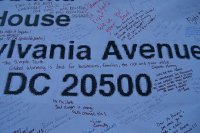Letters to the President: Make It a Student Tradition
Although most students will be watching Inauguration Day festivities from afar on January 21, they can get into the spirit of the day by putting pen to paper, or voice to video, and offering some second-term advice for their newly reelected president.
What are your students' hopes or concerns for the coming four years? In 2008, that writing prompt sparked a flood of more than 5,000 persuasive compositions and videos directed to President Barack Obama. Letters to the Next President, co-sponsored by the National Writing Project and Google, offers a handy template for planning an authentic writing project to coincide with the 2013 Inauguration.
Four years ago, students' concerns ranged from the struggling economy to immigration reform to the cost of a college education. As a pre-writing activity, you might have students critique a few posts about issues that matter most to them. (Posts from 2008 are tagged by topic and state, making them easy to sort.) What do your students notice about the letters that catch their attention? What makes for a compelling letter? Which writing techniques are most effective to make a persuasive argument? If your students had to choose just one letter to pass along to President Obama, which one would they select?
For more suggestions about how to plan a letter-writing project with presidential aspirations, watch the video featuring English teacher Ellen Shelton and her students from Tupelo, Mississippi. She explains how they used Google Docs to encourage collaboration and peer critique to help students improve their writing. She also describes how the project helped students find their voice as writers-and as citizens.
Let students know that writing to their president is a longstanding American tradition. As part of a history project, for example, students might scan newspaper archives or presidential libraries for letters from citizens from previous eras. Use the Library of Congress MyLOC feature to gather digital artifacts for classroom study.
Make sure your students' letters have an authentic audience. Here's more information about sending correspondence to the White House online or via old-fashioned mail. Let your students know that not every letter sent to the White House actually reaches the president's desk, but many do. Some students even get a personal response.
Publishing students' letters on a class blog or submitting them as letters to the editor of your local newspaper offers another way to connect your young writers with the world.
Finally, make the most of this authentic writing experience by writing alongside your students -- and sharing your letter with the world, too. In this post on the Engaging Educators blog, Ben Curran makes a case for attending to the achievement gap during the president's next term.
Which issues concern you and your students as we head into the next four years? Offer a preview in the comments.
